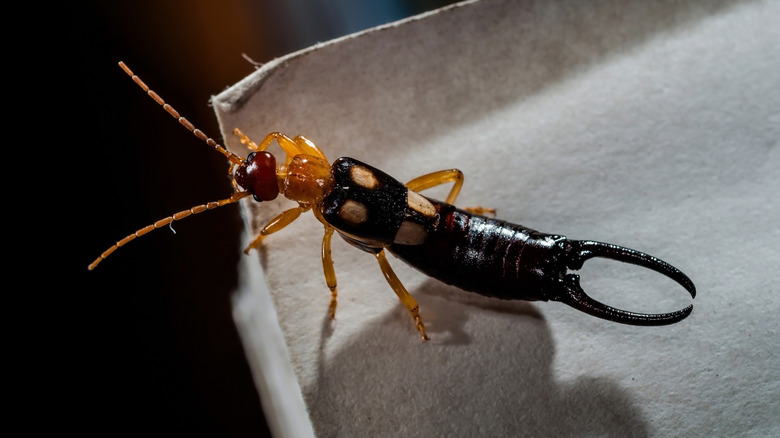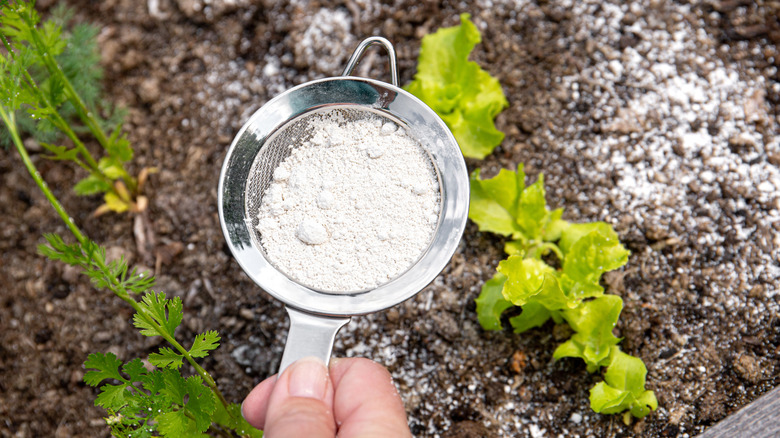The Secret Weapon That'll Eradicate Earwigs In Your Home And Garden
Despite their intimidating pincers, earwigs are much more of a nuisance than an actual threat, unless they've invaded your home in large numbers. While there are plenty of chemical sprays that can take care of the problem, one of the most effective eco-friendly solutions is diatomaceous earth (DE). This powdery substance is made from the fossilized remains of tiny aquatic organisms called diatoms and works quite well as an insecticide. DE doesn't poison the earwigs like a chemical pesticide would. Instead, its microscopic sharp edges pierce into their exoskeletons and soak up the oils and fats in their exoskeletons, causing them to eventually dehydrate and die.
Food-grade DE is useful inside the home because it is completely safe for humans and pets. It's non-toxic, doesn't leave harmful residues, and works for as long as it stays dry. Gardeners have relied on diatomaceous earth to easily take care of a variety of pests for years. If you're starting to see random earwigs popping up around your home, either in a damp basement or outside in the garden, DE can offer a simple, chemical-free way to eliminate them without harming your family or plants.
The right way to use diatomaceous earth against earwigs
Knowing the right ways to use diatomaceous earth around your home is the first step to being successful with its pest-control abilities. Since earwigs love dark, damp spaces, you'll want to focus on areas where they are most likely to hide: underneath flower pots, along baseboards, near any leaky pipes, or in garden mulch. Try to dry off the area as best you can before lightly dusting a thin layer of diatomaceous earth on the surface. The powder needs to stay dry to work, so if you're using it outside, make sure it's a sunny day without any rain in the forecast. If you're using it indoors, it may not work well in humid areas like bathrooms unless you're sure that you can keep the area dry.
Unlike chemical pesticides, diatomaceous earth doesn't allow earwigs and other bugs to develop a resistance to it. The powder clings to their bodies as they crawl through it, and within 24 to 48 hours, they'll dehydrate. If you've got a large infestation, try combining DE with other natural methods like a simple DIY cardboard earwig trap, or look for ways to reduce the moisture in infected areas. If using DE in the garden, avoid applying it directly to your flowers where pollinators might land as it can be harmful to beneficial insects as well. Instead, create a barrier around the perimeter of problem areas to keep earwigs out while allowing bees and butterflies to do their thing.
The do's & don'ts of diatomaceous earth
There are some important things to consider before using diatomaceous earth. First, always use food-grade DE, not the kind sold for pool filters. Those contain crystalline silica, which can be very harmful if inhaled. However, even with food-grade DE, it's best to wear a dust mask when applying it. Inhaling some of the fine particles could irritate your lungs. Pets and children should be kept away from freshly treated areas until the powder has settled to minimize any risk.
You also don't want to apply too much. Thicker layers of diatomaceous earth will not work any better than a light dusting. It might even work against you since earwigs will try to avoid larger piles, but a barely visible layer will still cling to their bodies. Finally, DE is great for killing earwigs that you see, but it won't help eliminate eggs that are hidden. Earwigs reproduce quickly, so you'll want to reapply the DE every few days for at least two weeks to break the life cycle. It's always best to combine diatomaceous earth with other prevention methods, like keeping damp areas clear of debris and sealing any cracks you see in your home. With some patience and persistence, this natural remedy can clear out earwig infestations without having to resort to synthetic chemical pesticides.


